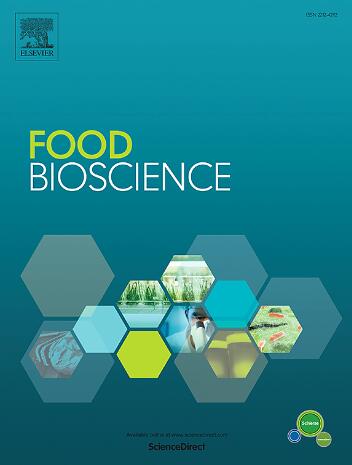利用浆果渣提取多酚化合物并将其与益生菌共同封装的价值评估
IF 4.8
1区 农林科学
Q1 FOOD SCIENCE & TECHNOLOGY
引用次数: 0
摘要
萨斯卡通浆果渣是一种富含抗氧化剂的副产品,可能适用于营养保健品和功能食品。本研究旨在将富含多酚的浆果提取物与益生菌共同封装,以利用浆果渣中的多酚化合物。共同封装的主要好处是多酚化合物能提高益生菌在胃肠道中的存活率。为了使这一过程具有成本效益,采用了传统的溶剂萃取法从浆果渣中提取多酚化合物。利用喷雾干燥法,使用植物基载体材料(豌豆蛋白分离物和阿拉伯树胶)共同封装多酚和益生菌。对喷雾干燥粉末的封装效率、胃肠道稳定性、生物可及性指数以及功能、结构和热特性进行了评估。研究发现,浆果渣是 TPC、DPPH 和 ABTS 的良好来源,分别为 2.49 毫克 GAE/1 克、4.48 毫克 QE/1 克和 2.96 毫克 QE/1 克。多酚类化合物和益生菌的封装效率(多酚类化合物和细菌在胶囊中的保留率)分别为 72.6% 和 94.4%。用多酚化合物封装的益生菌细胞在体外胃肠道消化过程中的存活率有所提高(9.08 log CFU/mL)。经肠道消化后,TPC 的生物利用率为 63.6%。据观察,喷雾干燥粉末具有良好的热稳定性,但功能特性较差,因此限制了其在烘焙食品、运动棒、谷物和其他对分散性要求不高的食品中的应用。因此,喷雾干燥法联合包囊为同时向肠道输送生物活性化合物和益生菌提供了一种高效且具有成本效益的方法,通过这种组合扩大了生物活性化合物和益生菌的益处。本文章由计算机程序翻译,如有差异,请以英文原文为准。
Valorization of berry pomace for extraction of polyphenol compounds and its co-encapsulation with probiotic bacteria
Saskatoon berry pomace, an antioxidant rich byproduct, may be suitable for nutraceuticals and functional foods. The present study aimed to co-encapsulate polyphenol-rich berry extract with probiotics to utilize the polyphenolic compounds present in berry pomace. The major benefit of co-encapsulation is that polyphenolic compounds increase the survival characteristics of probiotic bacteria in gastrointestinal tract. To make the process cost-effective, a conventional solvent extraction method was used for extraction of polyphenolic compounds from berry pomace. Spray drying was used to co-encapsulate polyphenols and probiotics by using plant-based carrier materials (pea protein isolate with gum Arabic). Spray dried powder was evaluated for encapsulation efficiency, gastrointestinal stability, bio-accessibility index, along with functional, structural and thermal characteristics. Berry pomace was found to be a good source of TPC, DPPH and ABTS with 2.49 mg GAE/1 g, 4.48 mg QE/1 g and 2.96 mg QE/1 g, respectively. The encapsulation efficiency (retention of polyphenolics and bacteria in capsules) of polyphenolic compounds and probiotics was 72.6% and 94.4%, respectively. Probiotic cells encapsulated with polyphenolic compounds showed improved survival (9.08 log CFU/mL) during in vitro gastrointestinal digestion. The bio-accessibility of TPC was 63.6% after intestinal digestion. The spray dried powder was observed to possess good thermal stability but poor functional properties, thus limiting applications to products such as bakery goods, sports bars, cereals and other foods where dispersibility is not imperative. Therefore, co-encapsulation by spray drying method offers an efficient and cost-effective method for simultaneous delivery of bioactive compounds and probiotics to the gut, extending their benefits by this combination.
求助全文
通过发布文献求助,成功后即可免费获取论文全文。
去求助
来源期刊

Food Bioscience
Biochemistry, Genetics and Molecular Biology-Biochemistry
CiteScore
6.40
自引率
5.80%
发文量
671
审稿时长
27 days
期刊介绍:
Food Bioscience is a peer-reviewed journal that aims to provide a forum for recent developments in the field of bio-related food research. The journal focuses on both fundamental and applied research worldwide, with special attention to ethnic and cultural aspects of food bioresearch.
 求助内容:
求助内容: 应助结果提醒方式:
应助结果提醒方式:


